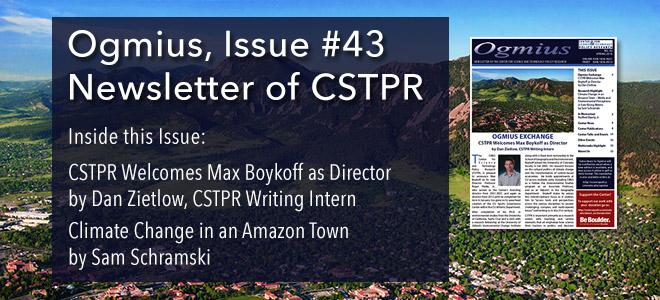Ogmius
Issue #43, Spring 2016
Ogmius Exchange
CSTPR Welcomes Max Boykoff as Director
by Dan Zietlow, CSTPR Writing Intern
The CIRES Center for Science and Technology Policy Research (CSTPR) is pleased to announce Max Boykoff as its new Director. Professor Roger Pielke, Jr., who served as the Center’s founding director from 2001-2007, and again as director from 2013 until he completed his term in January, has gone on to spearhead creation of the CU Sports Governance Center within the CU Athletic Department.
After completion of his Ph.D. in environmental studies from the University of California, Santa Cruz and a stint with a research fellowship at the University of Oxford’s Environmental Change Institute along with a fixed-term lectureship in the School of Geography and the Environment, Boykoff joined the University of Colorado faculty in Fall 2009. His research focuses on the cultural politics of climate change and the transformation of carbon-based economies. He holds appointments at CU across multiple units, including CIRES as a Fellow, the Environmental Studies program as an Associate Professor, and as an Adjunct in the Geography department. Boykoff states he enjoys this interdisciplinary focus as it enables him to “access tools and perspectives across the various disciplines to answer challenging, complex, and multi-layered issues” confronting us in the 21st century.
CSTPR is important primarily as a research center, with teaching and service elements that all emphasize how science finds traction in politics and decision making, how policy decision makers access scientific ways of knowing, and how science and policy can help people decide the type of futures they want for themselves and for their communities. Boykoff says this doesn’t merely take place with influential policy makers at the city, state, national, or international levels, but also importantly with “everyday people in society.” A number of initiatives that serve not only the CU-Boulder community, but also those “everyday people,” excite Boykoff, who strives in his role as Director to lead and support research from CSTPR faculty and students that take up science-policy challenges reaching varied audiences. “To be successful requires us to think smarter about reaching people where they are and helping them then to make what they consider to be ‘better’ decisions in the face of 21st century environmental challenges.” Read more …
Research Highlight
Climate Change in an Amazon Town: Media and Environmental Perceptions in Ever-Rising Waters by Sam Schramski
Our Research Highlight is authored by Dr. Sam Schramski. Sam was affiliated with CSTPR and the Center for Environmental Journalism in 2015 and 2016. He is a visiting postdoctoral scholar from the Federal University of Amazonas in Manaus, Brazil, and is based out of the Graduate Program in Amazonian Society and Culture. He has a Ph.D. in Interdisciplinary Ecology from the University of Florida. Sam has research interests in local and community-level climate change adaptation in the developing world, particularly in the Brazilian Amazon and southern Africa. He spent 2014 working on a field project that included perceptions of climate change amongst riverine populations living in Amazonian flooded forests. Sam is also a freelance journalist, having produced radio stories for NPR and Radio France International, and written blog posts for Brasil Post, Brazil’s Huffington Post affiliate.
In December I presented findings on my work on climate change perceptions within rural communities in the Brazilian Amazon. The research was preliminary and I hope it builds into further fieldwork in the not-too-distant future. My focus was on the relationship between the role of news media as a national purveyor of information in the context of limited regional media outlets and the lived experiences of individuals with whom I worked in the Mamirauá Reserve. The latter was primarily collected via interviews, especially with the elderly.
I began the presentation discussing media theory and the idea of cross-cultural interpretations of environmental changes mediated by television and, to a lesser extent, radio and the Internet. The key feature of the presentation was what I perceive to be an interesting feature of life in a dynamic ecological settings like Amazonian floodplain forests, where changes are constant and dramatic and media and policy formulations of what climate change has wrought (and will continue to wreak) don’t necessarily reflect this. I also highlighted what I feel are the important disjunctures between received media and public policy in settings very foreign to those displayed on TV in Brazil, where programming is not regional. The effect is that very little news content from areas in the vast North of the country are ever seen. Read more …


